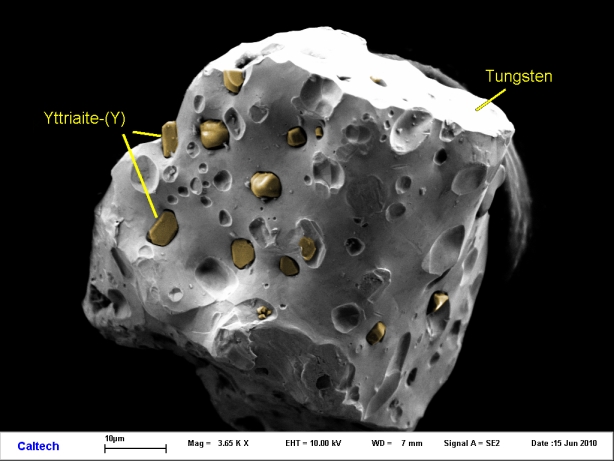Yttriaite-(Y): the natural occurrence of Y2O3
from the Bol'shaya Pol'ya River, Subpolar Urals Russia
Stuart
J. Mills
Department
of Earth and Ocean Sciences University
of British Columbia
Vancouver,
British Columbia, Canada V6T 1Z4
Pavel M. Kartashov
Institute of Geology Ore
Deposits Petrography, Mineralogy and Geochemistry (IGEM)
of
Russian Academy of
Sciences Staromonetnyi pereulok 35, 109017 Moscow, Russia,
Chi Ma, George R. Rossman
Division
of Geological and Planetary Sciences
California Institute of Technology, Pasadena,
California 91125, USA
Margarita
I. Novgorodova
Fersman
Mineralogical Museum, Leninskiy
Prospekt 18(2), Moscow
117071, Russia
Anthony
R. Kampf
Mineral
Sciences Department, Natural History Museum of Los Angeles County, 900
Exposition Boulevard, Los Angeles, California 90007, USA
Mati
Raudsepp
Department
of Earth and Ocean Sciences
University
of British Columbia,
Vancouver,
British Columbia, Canada
Abstract
Yttriaite-(Y),
ideally Y2O3, is a new mineral (IMA2010–039) from the alluvial deposits of the Bol'shaya
Pol'ya river, Subpolar Urals, Russia. The new mineral occurs as isolated
crystals, typically cubo-octahedra less than 6 μm
in size, embedded in massive native tungsten. Associated minerals include: copper, zircon, osmium, gold and pyrite. The main forms observed are {100}
and {111}. Due to the crystal
size, physical properties could not be determined; however, the
properties of
synthetic Y2O3 are well
known.
Synthetic Y2O3 crystals are colourless to white with a white streak;
crystals are transparent with an adamantine luster,
whilst massive Y2O3 is
typically translucent with an
earthy luster. Synthetic
Y2O3 has a Vickers
hardness of 653.91, which corresponds to 5.5 on the Mohs
scale.
Synthetic Y2O3
crystals have
good cleavage on {111}. Yttriaite-(Y) is isotropic; the refractive index measured at 587 nm on synthetic Y2O3 is n =
1.931. The
empirical chemical formula (mean of 4 electron microprobe analyses)
calculated
on the basis of 3 O is: Y1.98Dy0.01Yb0.01O3.
Yttriaite-(Y) is cubic, space group Ia-3,
with parameters a = 10.6018(7)
Å, V = 1191.62(7)
Å3 and Z = 16.
The five strongest lines in the
powder X-ray diffraction pattern (measured on synthetic Y2O3
using synchrotron radiation) are
[dobs
in Å (I) (hkl)]:
3.0646 (100) (222), 1.8746 (55) (440), 1.5984 (38) (622), 2.6537 (26)
(400) and
4.3356 (14) (211). The
mineral named is based on the common name for the chemical compound,
yttria.

Yttriaite-(Y) crystals
(false yellow color) included in tungsten metal from the Bol'shaya
Pol'ya river occurrence.

